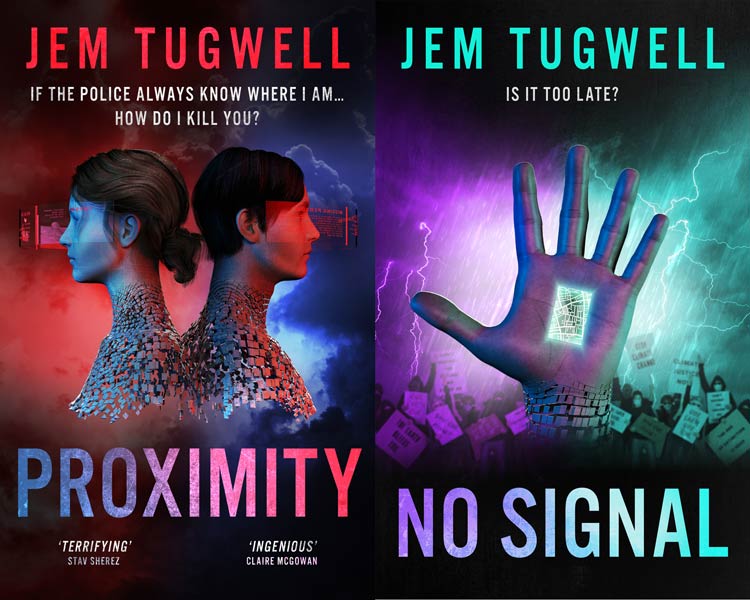Following the story of DI Clive Lussac, Jem Tugwell’s iMe series (consisting of Proximity, No Signal and a third edition – coming soon!), is a dystopian detective series full controlling technology, murder, corruption and more.
In the near future, Britons are now implanted with the iMe chip – a piece of implanted technology that has revolutionised day-to-day living. It can pay for your shopping, it can keep you connected, it can monitor your health (and what you eat)… and it can trace your every movement…
We spoke to Jem Tugwell about technology telling us what to do, government control and what we can expect in the next novel in the iMe series…
Where/when did you first get the idea for the iMe series?
The iMe idea started with a road sign. On a road near me with a 60mph speed limit, there is a sign the tells you to ‘slow down’ when you approach a corner. Any car can safely get around the corner at 40mph, but the sign lights up at any speed above 18mph. ‘Nanny state,’ I thought.
Then I heard announcements on escalators to ‘hold on’ and saw an advert for the National Health Service that said ‘one risk, is a risk too many’. It seemed like the health and safety directives were getting more and more intrusive and covering more and more aspects of our lives.
When I got a coffee machine, I found out that it nags incessantly: ‘fill the beans’, ’empty this’, ‘clean that’.
I am fascinated by how technology is accepted into our lives with little apparent thought for the consequences of how the data may be used. Even something as simple as a video doorbell is streaming images back to servers housed who knows where and accessible by the companies who provide the hardware and their staff.
So the idea of iMe came from the unholy four-way marriage of being nagged by a domestic appliance, an intrusive nanny state, the growing trend of health monitoring applications and the casual acceptance of tech in general.
If any, what were your inspirations when writing the novels?
I’ve always wanted to write thrillers since that’s what I like to read. I need an outlet for my imagination and writing has the appeal that you can do it almost anywhere. I’m naturally an introvert, so writing gives me the excuse to spend lots of time locked away in my own thoughts while still calling it work!
Where did the idea of the iMe implant itself come from?
The idea of the iMe implant came from looking at RFID technology, smartphones, health trackers etc and thinking ‘why would you want different tech from lots of different suppliers?’ If you had an RFID chip for each shop, bank and website you use, then your arm would soon be full. To me, it made more sense to have one implant that did everything. It made more sense to have iMe and let it ‘enable a better you’.
What came first for you, the technology aspect or the detective aspect of the story?
With Proximity and No Signal, the technology and the world of iMe definitely came first. Once I had thought through how the world would work it was clear that the world would shape the types of stories possible. I liked the idea that with 100% surveillance, crime would be diminished and then what would that do to the police force? So DI Clive Lussac was born – the man who helped introduce iMe to policing and inadvertently ruined his dream job. Once I had a main protagonist, I needed a crime for him to solve. And then another…

There’s a stylistic change between Proximity and No Signal – in Proximity, each chapter is from a different first-person POV, while for No Signal you use third-person, but still switching between POV. What was the reason behind this?
It was really to choose the best approach for each story.
The subplot of Proximity is to show the personal impact on Clive, from the older generation who grew up before iMe, his partner, DC Zoe Jordan, whose whole adult life has had iMe, and the Thief, who is trying to be outside the system. The best way to explore the differing thoughts and opinions of the three characters was to be ‘in their heads’ so first-person made the most sense.
With No Signal, there are more characters and much more going on outside of Clive and Zoe. The breadth of the story meant that it needed multiple POVs but I think that making them all first person would have been too confusing.
Also, the focus of No Signal is more on the world of iMe and how this type of technology could shape and change our behaviour and society and less on the personal impact on three individuals. The story being more distant from the protagonists also made it feel like third-person was the right choice.
The concept of the game in No Signal is very prescient, with Brexit looming how influential was real-world politics when writing the novel?
Although an isolated UK might seem Brexit-related, it wasn’t really an influence. The political trend of government interfering more and more in the details of our daily lives had significantly more influence on my designing iMe. We all live in a political world even if we try and ignore party politics. Diversity, equality, crime, climate change, etc. are around us all the time, so it’s natural for them to appear in the minds of the characters in fiction. Having two characters argue about a political topic is a great way to add some tension and drama into a story while also building characterisation and moving the story along.
What was the most difficult part/biggest hurdle in conceiving and designing the iMe system and how it impacts day to day life?
Firstly to get it plausible and relatable. I could have set the books further in the future and come up with a more extreme or advanced technology, but part of what I wanted to books to get across was how easily and soon we could be living in an iMe style world. I wanted the world to feel like an alternate now and readers to think ‘that could be my life’. This meant that the technology needed to ‘exaggerate’ current tech, maybe a few generations on. To me, it seems completely logical that a future version of today’s fitness trackers could be embedded, especially when you see the advances in things like Bluetooth enabled diabetes monitors that measure blood sugar levels.
The other issue with any world-building is consistency. Readers are brilliant at spotting holes in an imagined world and picking at the edges of the author’s thinking. Once I had the idea of iMe, I needed to think through the impact of politics, health, policing, crime and behaviour, etc. I have pages and pages of world-building looking at the rules of the world and how the different aspects interact. Most haven’t made it directly into the pages of each novel, but the groundwork is all there. This is also the reason why Proximity and No Signal have a different focus. Proximity looks more at the detail of the technology and its immediate impact on people and crime, while No Signal has more space to look at health care and immigration.
Would you want to get iMe installed in you?
If I look solely at the benefits, then yes. Who wouldn’t want no crime, better health and the end of identity theft? In the real world, the question really becomes: who runs the system? A corporation will have access to every tiny thing about you and would look for ways to turn that data into money. A government, irrespective of the political wing, will look at it as a way to control and tax. Either way, there would be no concept of personal privacy and both corporate and governments would have their own agenda and priorities. I’m not sure I’d trust them to act in my best interests, so I would have to say no to an iMe.
No Signal was a self-contained story, while Proximity expanded the world. What were the challenges in doing this?
The biggest challenge was not knowing the order a reader might read the books and this impacted on both the world and the story in No Signal.
As Proximity was the first book in the series, there were no real constraints on the story. The world of iMe was new to everyone, so I knew that I had to weave the world-building into the story to make it real. When I wrote No Signal I had no idea whether the reader had come to this book first or whether they already knew about iMe from reading Proximity. This made the world-building in No Signal much harder. If I explained everything, then someone who had read Proximity might find it repetitive. If I assumed the reader had read Proximity and knew the world, then I risked confusing a reader who hadn’t. I had to try and satisfy both readers! I hope I did.
The plotting problem for me with someone reading No Signal first, was one of spoilers. The crime element of Proximity’s storyline relies on multiple characters coming under suspicion. If the reader hasn’t read No Signal, then they know as much as the detectives and have to guess who they think the killer is. But if the reader knows a particular character is walking around free in No Signal, then they know that person is innocent when reading Proximity and it destroys the tension and intrigue.
How did I get around it? Any character from Proximity who were suspects, couldn’t feature in No Signal.
What can we expect from the next book in the iMe series?
The next iMe book, will see DI Clive Lussac face more challenges – with his battle against iMe, his health and chocolate craving. I want to look at the extremes of life under iMe and the differing styles of control mechanisms it brings. But fear not, it will all be wrapped in a fast-paced thriller with plenty of action…
